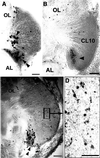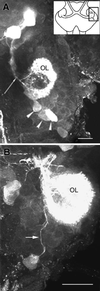Transient uptake of serotonin by newborn olfactory projection neurons
- PMID: 11675504
- PMCID: PMC60122
- DOI: 10.1073/pnas.231471298
Transient uptake of serotonin by newborn olfactory projection neurons
Abstract
A life-long turnover of sensory and interneuronal populations has been documented in the olfactory pathways of both vertebrates and invertebrates, creating a situation where the axons of new afferent and interneuronal populations must insert into a highly specialized glomerular neuropil. A dense serotonergic innervation of the primary olfactory processing areas where these neurons synapse also is a consistent feature across species. Prior studies in lobsters have shown that serotonin promotes the branching of olfactory projection neurons. This paper presents evidence that serotonin also regulates the proliferation and survival of projection neurons in lobsters, and that the serotonergic effects are associated with a transient uptake of serotonin into newborn neurons.
Figures





Similar articles
-
Serotonin depletion in vivo inhibits the branching of olfactory projection neurons in the lobster deutocerebrum.J Neurosci. 2000 Oct 15;20(20):7716-21. doi: 10.1523/JNEUROSCI.20-20-07716.2000. J Neurosci. 2000. PMID: 11027233 Free PMC article.
-
Effects of serotonin depletion on local interneurons in the developing olfactory pathway of lobsters.J Neurobiol. 2001 Feb 15;46(3):193-205. doi: 10.1002/1097-4695(20010215)46:3<193::aid-neu1002>3.0.co;2-8. J Neurobiol. 2001. PMID: 11169505
-
Cell-Type-Specific Modulation of Sensory Responses in Olfactory Bulb Circuits by Serotonergic Projections from the Raphe Nuclei.J Neurosci. 2016 Jun 22;36(25):6820-35. doi: 10.1523/JNEUROSCI.3667-15.2016. J Neurosci. 2016. PMID: 27335411 Free PMC article.
-
Presynaptic inhibition of olfactory receptor neurons in crustaceans.Microsc Res Tech. 2002 Aug 15;58(4):365-75. doi: 10.1002/jemt.10144. Microsc Res Tech. 2002. PMID: 12214303 Review.
-
Roles of odorant receptors in projecting axons in the mouse olfactory system.Curr Opin Neurobiol. 2007 Oct;17(5):507-15. doi: 10.1016/j.conb.2007.08.002. Epub 2007 Nov 1. Curr Opin Neurobiol. 2007. PMID: 17935969 Review.
Cited by
-
Birth, survival and differentiation of neurons in an adult crustacean brain.Dev Neurobiol. 2014 Jun;74(6):602-15. doi: 10.1002/dneu.22156. Epub 2013 Dec 14. Dev Neurobiol. 2014. PMID: 24339155 Free PMC article.
-
From Blood to Brain: Adult-Born Neurons in the Crayfish Brain Are the Progeny of Cells Generated by the Immune System.Front Neurosci. 2017 Dec 7;11:662. doi: 10.3389/fnins.2017.00662. eCollection 2017. Front Neurosci. 2017. PMID: 29270102 Free PMC article. Review.
-
Identification and developmental expression of the enzymes responsible for dopamine, histamine, octopamine and serotonin biosynthesis in the copepod crustacean Calanus finmarchicus.Gen Comp Endocrinol. 2014 Jan 1;195:28-39. doi: 10.1016/j.ygcen.2013.10.003. Epub 2013 Oct 19. Gen Comp Endocrinol. 2014. PMID: 24148657 Free PMC article.
-
Hormonal and synaptic influences of serotonin on adult neurogenesis.Gen Comp Endocrinol. 2008 Sep 1;158(2):183-90. doi: 10.1016/j.ygcen.2008.07.016. Epub 2008 Aug 3. Gen Comp Endocrinol. 2008. PMID: 18692503 Free PMC article.
-
An identified serotonergic neuron regulates adult neurogenesis in the crustacean brain.Dev Neurobiol. 2009 Jul;69(8):530-45. doi: 10.1002/dneu.20722. Dev Neurobiol. 2009. PMID: 19373861 Free PMC article.
References
Publication types
MeSH terms
Substances
LinkOut - more resources
Full Text Sources

